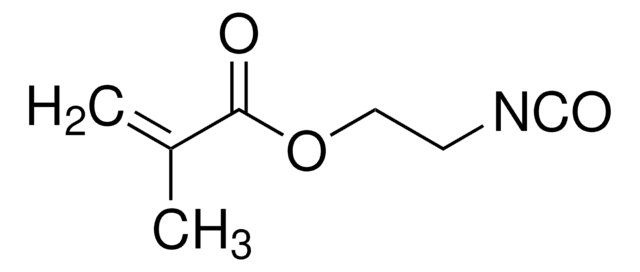305405
Octadecyl isocyanate
≥90%
Synonym(s):
1-Isocyanatooctadecane, 1-Octadecyl isocyanate, ODI, Stearyl isocyanate, n-Octadecyl isocyanate
About This Item
Recommended Products
vapor pressure
1 mmHg ( 154 °C)
Assay
≥90%
refractive index
n20/D 1.45 (lit.)
bp
172-173 °C/5 mmHg (lit.)
mp
15-16 °C (lit.)
density
0.847 g/mL at 25 °C (lit.)
storage temp.
2-8°C
SMILES string
CCCCCCCCCCCCCCCCCCN=C=O
InChI
1S/C19H37NO/c1-2-3-4-5-6-7-8-9-10-11-12-13-14-15-16-17-18-20-19-21/h2-18H2,1H3
InChI key
QWDQYHPOSSHSAW-UHFFFAOYSA-N
Looking for similar products? Visit Product Comparison Guide
Application
- surface of cellulose nanocrystals to promote interfacial filler/matrix interactions
- poly (2-hydroxyethyl methacrylate) (pHEMA) films, to investigate in vitro hemocompatibility assay using freshly drawn human whole blood
- cellulose nanocrystals (or whiskers) and microfibrillated cellulose (MFC)
Signal Word
Danger
Hazard Statements
Precautionary Statements
Hazard Classifications
Acute Tox. 4 Dermal - Acute Tox. 4 Inhalation - Acute Tox. 4 Oral - Eye Irrit. 2 - Resp. Sens. 1 - Skin Irrit. 2 - Skin Sens. 1 - STOT SE 3
Target Organs
Respiratory system
Storage Class Code
6.1C - Combustible acute toxic Cat.3 / toxic compounds or compounds which causing chronic effects
WGK
WGK 1
Flash Point(F)
300.2 °F - closed cup
Flash Point(C)
149 °C - closed cup
Personal Protective Equipment
Certificates of Analysis (COA)
Search for Certificates of Analysis (COA) by entering the products Lot/Batch Number. Lot and Batch Numbers can be found on a product’s label following the words ‘Lot’ or ‘Batch’.
Already Own This Product?
Find documentation for the products that you have recently purchased in the Document Library.
Customers Also Viewed
Our team of scientists has experience in all areas of research including Life Science, Material Science, Chemical Synthesis, Chromatography, Analytical and many others.
Contact Technical Service














